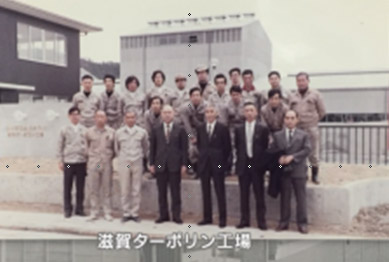HIRAOKA & CO., LTD. will celebrate its 120th anniversary.
HIRAOKA reaches its 120th anniversary this year since its business inauguration in 1902. It made a permanent effort to change itself and take on new challenges from Meiji Period to Taisho, Showa, Heisei and Reiwa Periods.
-
1902
Sometatsu Dyeing Factory started its business~From yarn dyeing to fabric dyeing~
-

Tatsujiro Hiraoka and Hana established Sometatsu Dyeing Factory.
With an inexhaustible inquiring mind, they developed the factory to “Sometatsu of Chemical Dyeing”In August 1902, Tatsujiro Hiraoka and Hana started business under the name of Sometatsu Dyeing Factory in Minowamachi, Kitatoshima-gun, Tokyo Pref. (currently, Minowa, Taito-ku, Tokyo). When they started the business, the yarn dyeing was in the early developmental stage and they mainly worked on scouring breach and dyeing for cotton and linen. Then, developing their business area from yarn dyeing to fabric dyeing in 1907, they dyed velveteen corduroys for the first time in the Kanto region. In 1910, the factory exclusively undertook order placements from Oni Tabi K.K., a leading manufacturer of tabi (Japanese digitated socks) which had enjoyed a large demand equal to Fukusuke Tabi K.K. in the Kansai region. Since then, their business was focused on the dyeing of velveteen corduroys.
-
1935
Birth of HIRAOKA & CO., LTD. ~From clothing to industrial materials~
-

Having a major turning point from dyeing to dyeing/waterproof treatments.
Sometatsu Dyeing Factory was restructured to HIRAOKA & CO., LTD. on February 11, 1935. Its operation was shifted from the dyeing of velveteen corduroys to the dyeing and waterproofing of canvases. While changing its operation drastically from clothing to resin processing for industrial materials, it was forced to undergo a change in business from peacetime industries to munitions production in 1937.
-
1940s to 1950s
Birth of new HIRAOKA & CO., LTD. ~To a new stage along with the end of WWII and post-war restoration~
-

Establishing the fire prevention/waterproof processing technologies for synthetic fiber canvases
Advancing to “HIRAOKA of Technology”In 1947, two years after the end of WWII, Yoshiji Hiraoka assumed the position as the second Representative Director and President. The company developed Japan-first fire prevention and waterproof processing technologies for cotton canvases in 1950 and likewise Japan-first fire prevention and waterproof processing technologies for synthetic fiber canvases in 1954. The establishment of original new technologies was aligned with the post-war prosperity of synthetic fibers, making people broadly recognize the company as the HIRAOKA of Technology.
-
1960s
Along with the post-war high economic growth ~Period to expand manufacturing/operation sites~
-

Soka Plant equipped with the newest system was completed, and Osaka Business Office was also open.
Manufacturing sites to translate technologies into products were completed, as exemplified by Soka Plant in 1962 and Soka Plastic Plant in 1968. In addition, Osaka Business Office, which would be promoted to Osaka Branch later, was open in 1965. The company had thus developed into a nationwide enterprise against the backdrop of the post-war high economic growth.
-
1970s to 1980s
The end of the post-war high economic growth ~Further development of new technologies and enrichment of the product lineup~
-

Entering the leather and tarpaulin areas
After conquering twice oil crisesThe company developed a backing technology in 1971 and high frequency welder sewing technology for cotton canvases in 1980, respectively, as well as started to sell “Hiraoka U Tape” and the “Tarpo Screen®” series, a curing mesh for construction. It continuously developed new technologies and enhanced its product lineup in this period. It also completed Shiga Tarpaulin Plant in 1974, joining the leather and tarpaulin areas in full scale.
-
1990 to 2010
Getting through the tough times at a time of drastic change ~Take a step as a global enterprise~
-

Pursuing company growth with challenges as a lesson
The industry had suffered from a deadlock as represented by the reduced demands for the industrial fabrics since the collapse of the bubble economy in 1991. However, the company aggressively worked to explore new sales channels, the number of which had been limited, and proactively enrich the product lineup, thus independently finding new business opportunities. In this way, it has never stopped to take a step as a global enterprise, and despite tough times such as the bankruptcy of Lehman Brothers and Great East Japan Earthquake, it reached the current position.
-
2019 and to the future
Challenge for the future ~Never satisfied with our past and move toward a new horizon~
-
We celebrated our 120th anniversary. From now on, HIRAOKA endeavors to grow as a global company by expanding into overseas markets and create new businesses.

